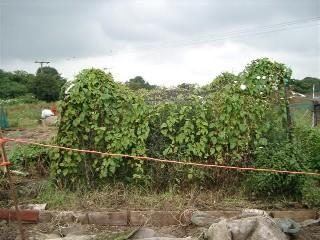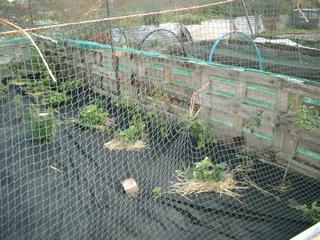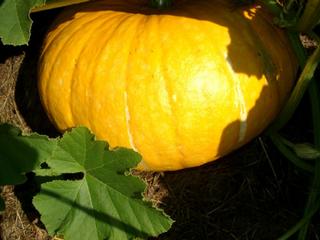 Over the winter months of 2004 the allotment looked bare but manageable. The rubbish cleared, and the foliage dead, I set too trying to create some order in readiness for the spring.
Over the winter months of 2004 the allotment looked bare but manageable. The rubbish cleared, and the foliage dead, I set too trying to create some order in readiness for the spring.I collected some old wooden pallets from the village builders yard - for the cost of donations to the charity box. I used these to create a compost bin covered with strong plastic to protect it from the elements. It took me hours and when finished I remember that glow of pride at my first achievement. (Isn’t naivety bliss?) If only I had known that by the time spring had arrived, rats would have eaten most of the plastic and mice would have set up home in the cosy cavity I had created – the perfect homestead, and complete with it’s own food source of kitchen waste!
I found a weed-filled pond, no water in it thankfully as I had stumbled over the weeds, but a pond liner – yippee – was it worth the hours I spent hauling and digging out all the weeds and junk that had accumulated in it? Yes, because I managed to drag the liner out in its entirety, fill the hole with lots of dead foliage, and use the liner to cover it all up, together with a large amount of dock weeds and thistles, and left them to rot until this year, when I uncovered it to reveal a large area of soil, with the consistency of topsoil, without a weed in sight.

But I digress; my next project was to clear this object in the photo. Now I could have just set fire to it or cut it all down, as thistles were growing out of the top which was at least six feet high, but no, I took three weekends to unravel the bind weed, extricate the netting from the myriad of weeds anchoring it on all sides to the ground, and at the end of it I had the start of what is now my fruit cage. All it needed was a bit of imagination and lots of hard work. More trips and donations for wooden pallets, salvaged old pipes hammered into the ground to keep them upright, plastic milk cartons on top to stop them tearing the netting, and green wind barrier material, again found on the allotment stapled all around to keep the rabbits and wind out. Now that has been a success.

Spring 2004 arrived with a vengeance of appalling weather so no work could get done on the lottie until the rain finally stopped leaving a cloggy mess. I managed to get myself an old rotorvator and got it serviced and repaired ready to turn the plot into my veggie paradise. Reality has a cruel habit of shattering my day dreams. The old rotorvator, when it finally started, coughed and spluttered a few feet, then died each time I used it. This involved many trips taking it back to be fixed after the 6th time, I was totally demoralised and defeated. So any of you thinking about getting an old machine, think twice if you are not a ‘tinkerer’. I now know why all the men up the allotments are forever tinkering and fiddling with the things – the old ones are prone to be very temperamental.
April was fast disappearing and everyone had planted their potatoes in neat rotorvated rows, that had then been drilled out into a long trench ready for them to just drop theirs in. The only way I was able to get my potatoes in was to use my spade almost like a pick axe to make a hole and put seed potato in. By which time they looked like aliens with white shoots six inches tall. Yes I had read the books,and had torn up bags full of newspaper to line the trenches, but again, the books I read were written for Gardeners World type allotments, where the soil is all topsoil or crumbly light stuff full of compost etc etc. Light years away from the soil I had to deal with! And how was I to know that 5 x 3kg bags of a variety of potatoes would be enough to get a contract with McCains? It was May before they were all planted. And June this year before we finished eating those that we had not given away.
The allotment had by then been transformed from a neat barren site into one bursting with evil looking weeds with roots on them so long and thick, that I despaired of ever removing them all. I know that if you leave a bit in they will grow again, but what can you do if they are set like concrete deep into the ground? I was beginning to realise that 330 feet was awful lot of area to dig by spade.
I nearly gave up, as day by day I toiled and slaved and ached and injured my muscles. But I am a stubborn ‘old bird’ and pride would not let me. So I gradually I created, bit by bit, a manageable sized plot of veggies with my husband helping me with the heavy digging when he was not playing golf or bowling. (Which wasn't often, but often enough to lift my morale.

I got some old salvaged chicken wire and fenced off a manageable area and concentrated on that. Then I extended it another 20 feet to include some fruit bush cuttings and some flowers.
 I was so proud of my achievements, and produce last year, but ended up giving most of it all away, as we did not have a big freezer so couldn’t freeze many veggies (that has now been rectified), but I did have many happy neighbours and family and friends who opened their doors to carrier bags filled with potatoes, runner beans, climbing beans, courgettes, sweet corn etc on their doorsteps.
I was so proud of my achievements, and produce last year, but ended up giving most of it all away, as we did not have a big freezer so couldn’t freeze many veggies (that has now been rectified), but I did have many happy neighbours and family and friends who opened their doors to carrier bags filled with potatoes, runner beans, climbing beans, courgettes, sweet corn etc on their doorsteps.The work had been hard, but I was on a learning curve and the lessons I learnt the hard way put me in good stead for this year.
But the most soul destroying part, is that on either side of me, are plots where the weeds are left to grow wild – and the leasees’ have all ‘the gear’ to sort them out in a jiffy. (Tractors, rotorvators. But from reading other allotment write-ups, that seems often the norm. People take on allotments, and because they are cheap to lease, they would rather just keep them and pay the small fee, than give them up. Sometimes I think that is because it is easier to let them grow wild than to tidy them up and get them ‘clean’ to hand over to a new tenant.
Last summer I was chatting to a couple of the ‘old boys’ who had had allotments for many years, and was hoping for a bit of encouragement being the newcomer. But they were full of doom and gloom saying that it was a waste of time and that what was left after the rabbits, pigeons, flocks of birds, caterpillars, and other pests, and the occasional deer, had been at them was hardly worth all the effort. But when I asked their age one was in his seventies and the other his 80’s (albeit the older of the two had a half plot), I laughed and said that if I am still able to be doing it at their age, then I’ll not begrudge all the animal life from tucking in, obviously the continual battle with them and the elements is what keeps us gardeners going!
No comments:
Post a Comment
Thank you for visiting and leaving a comment - it is very much appreciated. Your comment will appear after moderation.